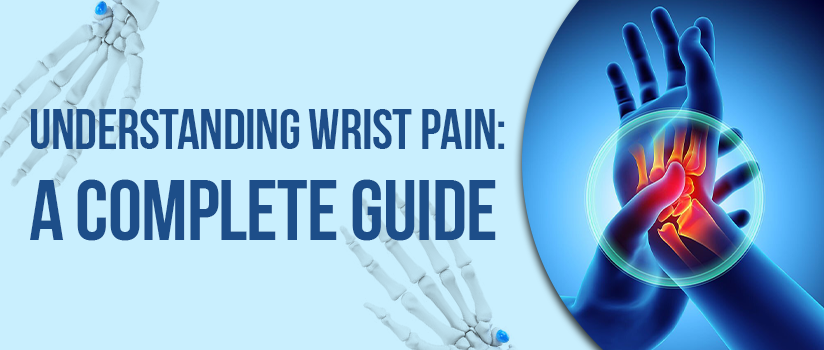
Wrist pain can be a troubling condition that affects the joint connecting the hand and forearm. The wrist joint consists of numerous small bones that enable us to perform a range of movements such as bending, straightening, and rotating the hand. If you experience pain, numbness, or tingling sensations in this area, you may suffer from wrist pain. However, it’s important to note that wrist pain is treatable, and there’s no need to worry. Let’s delve into the causes, treatments, and preventive measures associated with wrist pain.
Causes of Wrist Pain
Wrist pain can occur due to various reasons, with trauma being a primary cause. If you have recently experienced a fall and landed on your wrist, it is likely to result in pain due to the stress and trauma endured by the joint. An X-ray can help determine if the impact has caused a sprain, fracture, or partial ligament disruption.
In some cases, wrist pain may appear without apparent cause, with symptoms that come and go. When the symptoms worsen or persist for an extended period, it is referred to as chronic wrist pain. In such instances, seeking medical attention from a healthcare provider who can carefully examine the pain and conduct appropriate imaging studies to identify the underlying cause is advisable. Here are some of the most commonly identified causes of wrist pain:
1. Carpal Tunnel Syndrome
This is a prevalent hand-related condition that leads to pain, numbness, weakness, and tingling sensations in the hand and wrist. Repetitive hand movements or lifting heavy weights can result in increased pressure on the median nerve, which passes through the wrist and facilitates sensory perception and hand movement.
2. Tendinitis
The wrist contains a complex network of tendons that enable wrist movement and finger mobility. When these tendons become irritated, they may swell, causing pain during movement or an increased risk of tendon rupture. De Quervain’s Tenosynovitis, which is commonly observed on the thumb side of the wrist, is a well-known form of tendinitis characterized by severe pain when combining thumb and wrist movements.
3. Ganglion Cysts
Ganglion cysts are benign, fluid-filled lumps that develop around the wrist joints and tendons. These cysts can exert pressure on the nerves in the wrist, leading to numbness, tingling sensations, or a dull ache. Although not usually serious, ganglion cysts can be uncomfortable.
4. Gout
Gout is characterized by inflamed joints that are painful, sore, and swollen. The affected area may feel warm to the touch. Gout occurs due to the accumulation of excess uric acid in the bloodstream, which subsequently leads to the formation of painful crystals in the joints and surrounding tissues.
5. Osteoarthritis
Wrist pain can also result from the wear and tear of the cartilage in the wrist bones. As a result, bones rub against each other, causing pain, swelling, and stiffness.
6. Psoriatic Arthritis
Individuals with psoriasis may develop psoriatic arthritis, which can also cause wrist pain, tenderness, swelling, and reduced range of motion.
7. Rheumatoid Arthritis
This autoimmune disease primarily affects the small joints of the hands and wrists. Like other forms of arthritis, rheumatoid arthritis leads to joint pain, swelling, and stiffness.
Other causes of wrist pain include lupus, wrist infections, tumors, avascular necrosis of the carpal bone, and cervical nerve compression.
Treatment Options for Wrist Pain
The treatment approach for wrist pain depends on the underlying cause. In cases of severe pain, orthopedic specialists may recommend a protective splint or cast to support and immobilize the affected area, especially in the case of fractures, sprains, or arthritis. If a fracture is unstable, surgery may be necessary to facilitate proper healing. Timely surgical intervention can address the root cause of the problem effectively. You can use the following techniques at home to help treat wrist pain:
- Apply a cold compress to acute injuries.
- Apply a warm compress for chronic pain.
- Engage in hand exercises guided by a physiotherapist.
- Use over-the-counter or topical nonsteroidal anti-inflammatory drugs for pain relief.
In cases of chronic pain, an orthopedic specialist may recommend the following:
- Oral or intravenous medications to alleviate pain.
- Carpal tunnel surgery if there is pressure on the median nerve.
- Surgery to release tendon compression.
- Surgical interventions to address bone-to-bone friction in arthritis patients.
- Motion-preserving procedures such as wrist fusion, bone removal, or wrist replacement.
- Wrist debridement surgery to remove inflamed scar tissue causing pain.
Orthopedic surgeons nowadays often prefer using arthroscopic (minimally invasive) techniques to ensure faster recovery and complete treatment.
Preventing Wrist Pain
As the saying goes, prevention is better than cure. When it comes to wrist pain, repetitive movements can exacerbate the condition. For instance, spending prolonged periods typing can lead to wrist pain. Here are some preventive measures you can take:
- Position your keyboard lower to avoid upward bending of the wrists.
- Take periodic breaks and rest your hands.
- Use a wrist rest for support.
- Consider using the mouse with both hands to distribute the workload evenly.
In conclusion, identifying the underlying cause of wrist pain is crucial in determining the appropriate treatment. If you are uncertain about persistent pain that doesn’t resolve on its own, it is always advisable to consult an orthopedic specialist who can help diagnose and resolve the issue. At the Kothari Medical Centre, our team of experts and orthopedic surgeons is dedicated to providing the best solutions for a speedy recovery and effective treatment of wrist pain.



